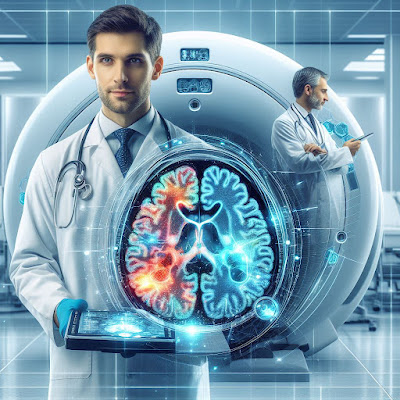Introduction:
In the realm of modern healthcare, medical imaging stands as a cornerstone of diagnosis, treatment planning, and monitoring of various medical conditions. From X-rays and ultrasounds to MRI and CT scans, medical imaging technologies enable healthcare providers to visualize internal structures, detect abnormalities, and guide interventions with unprecedented precision. In this comprehensive guide, we'll delve into the world of medical imaging, exploring its diverse modalities, applications across medical specialties, and the transformative impact it has on patient care.
 |
| Medical Imaging |
Understanding Medical Imaging:
Medical imaging encompasses a broad range of techniques and technologies used to create visual representations of the human body for diagnostic and therapeutic purposes.
These techniques utilize different forms of energy, such as X-rays, sound waves, radio waves, and magnetic fields, to generate detailed images of anatomical structures, physiological processes, and pathological changes. Some of the most common modalities of medical imaging include:X-ray Imaging: X-ray imaging, also known as radiography, is one of the oldest and most widely used modalities of medical imaging. It uses ionizing radiation to create two-dimensional images of bones, soft tissues, and internal organs, allowing healthcare providers to diagnose fractures, detect tumors, and evaluate the presence of foreign bodies.
Computed Tomography (CT) Scan: CT scanning combines X-ray technology with computer processing to produce cross-sectional images of the body. CT scans offer high-resolution images of internal structures, including the brain, chest, abdomen, and pelvis, making them valuable tools for diagnosing a wide range of conditions, such as stroke, cancer, and trauma.
Magnetic Resonance Imaging (MRI): MRI utilizes a powerful magnetic field and radio waves to create detailed images of soft tissues, organs, and blood vessels without the use of ionizing radiation. MRI is particularly well-suited for imaging the brain, spinal cord, joints, and soft tissues, providing valuable information for diagnosing neurological disorders, musculoskeletal injuries, and cardiovascular diseases.
Ultrasound Imaging: Ultrasound imaging, also known as sonography, uses high-frequency sound waves to visualize internal structures in real-time. Ultrasound is commonly used to assess fetal development during pregnancy, evaluate the heart and blood vessels, and guide minimally invasive procedures such as biopsies and injections.
Nuclear Medicine: Nuclear medicine imaging involves the administration of radioactive tracers, which are taken up by specific organs or tissues and emit gamma rays. By detecting the distribution and metabolism of these tracers, nuclear medicine imaging techniques, such as positron emission tomography (PET) and single-photon emission computed tomography (SPECT), can provide valuable information about cellular function, metabolism, and disease processes.
Applications of Medical Imaging:
Medical imaging plays a critical role in virtually every medical specialty, offering valuable insights into the diagnosis, treatment, and management of a wide range of conditions. Some common applications of medical imaging include:
Diagnostic Imaging: Medical imaging is essential for diagnosing various medical conditions, including fractures, tumors, infections, and cardiovascular diseases. Imaging studies such as X-rays, CT scans, and MRI help healthcare providers visualize anatomical structures and identify abnormalities that may not be apparent on physical examination alone.
Treatment Planning: Medical imaging guides treatment planning and decision-making in numerous medical specialties, including oncology, neurology, and orthopedics. For example, imaging studies such as MRI and CT scans help oncologists determine the extent of tumor involvement, assess treatment response, and plan radiation therapy or surgery.
Interventional Procedures: Medical imaging plays a crucial role in guiding minimally invasive procedures, such as biopsies, injections, and catheter-based interventions. Techniques such as fluoroscopy, ultrasound, and CT guidance enable healthcare providers to precisely target lesions, deliver therapeutic agents, and monitor treatment response in real-time.
Monitoring Disease Progression: Medical imaging is valuable for monitoring disease progression and treatment response over time. Serial imaging studies, such as MRI scans and PET/CT scans, allow healthcare providers to assess changes in tumor size, metabolic activity, and treatment-related side effects, guiding adjustments to therapy as needed.
Research and Innovation: Medical imaging drives innovation and research in healthcare, facilitating the development of new diagnostic techniques, therapeutic approaches, and medical devices. Imaging technologies such as functional MRI (fMRI), diffusion tensor imaging (DTI), and molecular imaging enable researchers to study brain function, neural connectivity, and disease mechanisms with unprecedented detail and precision.
Conclusion:
Medical imaging has revolutionized the practice of medicine, providing healthcare providers with powerful tools for diagnosis, treatment planning, and monitoring of various medical conditions. From X-rays and CT scans to MRI and ultrasound, medical imaging modalities offer valuable insights into the structure, function, and pathology of the human body, enabling timely and accurate clinical decision-making. As technology continues to advance and new imaging techniques emerge, the future of medical imaging holds promise for further enhancing patient care, improving outcomes, and driving innovation in healthcare.







